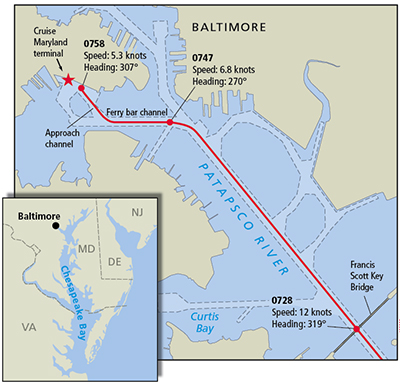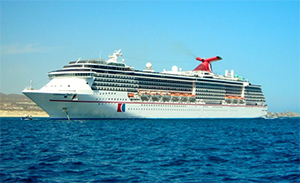The cruise ship Carnival Pride rammed a Baltimore Harbor pier because the staff captain allowed the vessel to approach too fast and at too steep an angle, according to the National Transportation Safety Board (NTSB).
The 963-foot ship was returning from a seven-day cruise to Florida and the Bahamas when the incident occurred at 0800 on May 8, 2016. The ship’s bow struck the pier, fendering and an elevated passenger walkway on shore, causing nearly $2.1 million in damage. Three vehicles that were under the walkway as it collapsed were damaged, and the ship sustained minor cosmetic damage. There were no injuries.
As Carnival Pride approached the Cruise Maryland terminal, the pilot handed the conn to the ship’s captain and the staff captain, per an agreement between the Association of Maryland Pilots and passenger vessels berthing at the terminal, the NTSB said in its accident report.
The pilot had developed a familiar working relationship with the ship’s captain during previous transits but had never met the staff captain, who was second in command. Following the changeover, the pilot assumed an advisory role, giving direct orders for the helm and engines.
The staff captain had previous experience operating the controls during berthing maneuvers under the captain’s supervision. With a push of a button, the staff captain accepted control of the engines and helm at the console, which was in joystick mode. The joystick tested and operated normally to his satisfaction, the NTSB said.
The pier heading at the Cruise Maryland terminal was 284 degrees, but when the bow of Carnival Pride was about half a ship’s length away from the dock, the vessel was on a heading of 307 degrees at a speed of 5.3 knots.
At about that time, the pilot cautioned the staff captain, saying, “You need to slow down,” according to conversation captured by the ship’s voyage data recorder.
 |
|
The red line on the chart shows the ship’s approach to the pier; the red star marks the accident location. |
|
Pat Rossi illustration |
The staff captain realized that the angle of approach was too steep and that the ship was going too fast. In order to gain more thrust, as well as to reduce the vessel’s rate of closure, he attempted to transfer from joystick to manual control at the bridge wing console in order to maneuver away from the dock.
“Despite repeated attempts, the staff captain’s efforts to transfer control to the manual levers were unsuccessful,” the NTSB report states.
As Carnival Pride continued to approach the dock, the captain took the conn from the staff captain and shifted engine and helm control back to the center console. The captain regained full control of the azipods and thrusters, applying full thrust away from the berth. The maneuver slowed the ship’s forward progress, but not before the bulbous bow struck the pier’s fendering and support columns.
As the ship continued moving forward, the elevated passenger walkway was hit by the vessel’s flared bow. The walkway was then struck by Carnival Pride’s starboard-side retractable observation and mooring platform, which caused the walkway to collapse on top of three port department vehicles parked on the pier.
In its analysis, the NTSB stated that the staff captain allowed the vessel to approach the pier too fast and at an angle too steep because he misjudged the power available in the joystick mode for correcting the maneuver.
“In the seconds it took him to assess that the joystick control would not be enough, in his opinion, to slow the ship, he lost valuable time in shifting to manual control,” the report stated.
When contacted by Professional Mariner, Carnival declined to comment on the incident. The Association of Maryland Pilots also had no comment.

